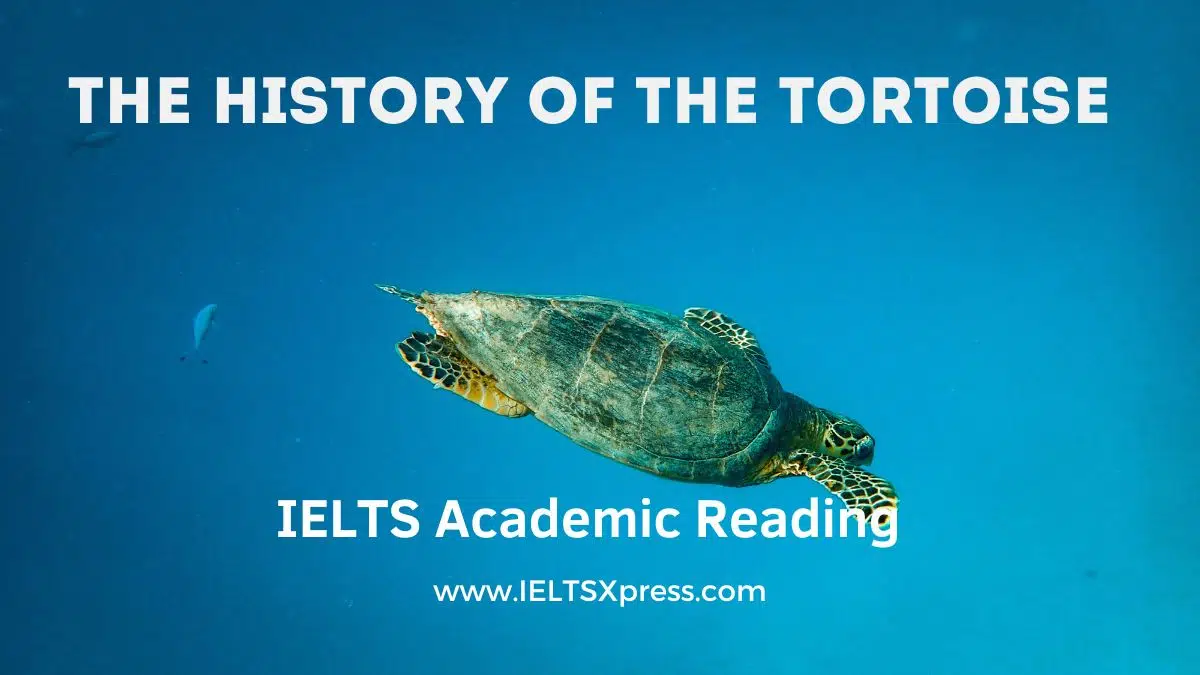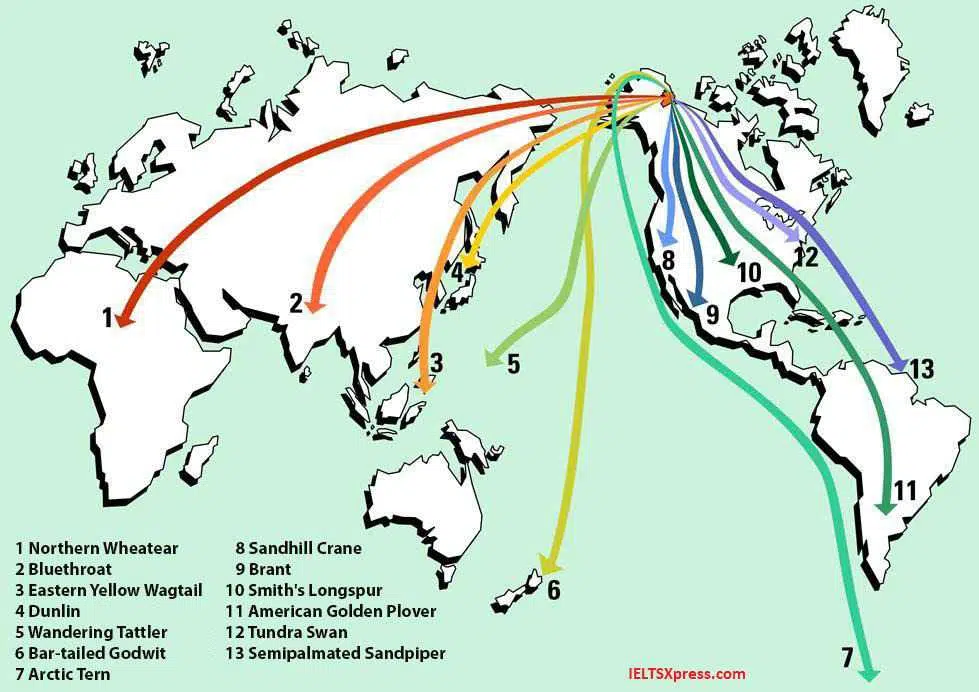The History of The Tortoise IELTS Reading Academic
Reading Passage 3
The History of The Tortoise
A. If you go back far enough, everything lived in the sea. At various points in evolutionary history, enterprising individuals within many different animal groups moved out onto the land, sometimes even to the most parched deserts, taking their own private seawater with them in blood and cellular fluids. In addition to the reptiles, birds, mammals and insects which we see all around us, other groups that have succeeded out of water include scorpions, snails, crustaceans such as woodlice and land crabs, millipedes and centipedes, spiders and various worms. And we mustn’t forget the plants, without whose prior invasion of the land none of the other migrations could have happened.
B. Moving from water to land involved a major redesign of every aspect of life, including breathing and reproduction. Nevertheless, a good number of thoroughgoing land animals later turned around, abandoned their hard-earned terrestrial re-tooling, and returned to the Water Seals have only gone part way back. They show us what the intermediates might have been like, on the way to extreme cases such as whales and dugongs. Whales (including the small whales we call dolphins) and dugongs, with their close cousins the manatees, ceased to be land creatures altogether and reverted to the full marine habits of their remote ancestors. They don‘t even come ashore to breed. They do, however, still breathe air, having never developed anything equivalent to the gills of their earlier marine incarnation. Turtles went back to the sea a very long time ago and, like all vertebrate returnees to the water, they breathe air. However, they are, in one respect, less fully given back to the water than whales or dugongs, for turtles still lay their eggs on beaches.
C. There is evidence that all modem turtles are descended from a terrestrial ancestor which lived before most of the dinosaurs. There are two key fossils called Progaochelys quenstedtiand Palaeochersis talampayensis dating from early dinosaur times, which appear to be close to the ancestry of all modem turtles and tortoises. You might wonder how we can tell whether fossil animals lived on land or in water, especially if only fragments are found. Sometimes it`s obvious. Ichthyosarus were reptilian contemporaries of the dinosaurs, with fins and streamlined bodies. The fossils look like dolphins and they surely lived like dolphins, in the water. With turtles it is a little less obvious. One way to tell is by measuring the bones of their forelimbs.
D.
Walter Joyce and Jacques Gauthier, at Yale University, obtained three measurements in these particular bones of 71 species of living turtles and tortoises. They used a kind of triangular graph paper to plot the three measurements against one another. All the land tortoise species formed a tight cluster of points in the upper part of the triangle; all the water turtles cluster in the lower part of the triangular graph. There was no overlap, except when they added some species that spend time both in water and on land. Sure enough, these amphibious species show up on the triangular graph approximately half way between the ‘wet cluster’ of sea turtles and the ‘dry cluster’ of land tortoises. ‘The next step was to determine where the fossil fell. The bones of P quenstedti and P. talampayensis leave us in no doubt. Their points on the graph are right in the thick of the dry cluster. Both these fossils were dry-land tortoises. They come from the era before our turtles returned to the water.
E. You might think, therefore, that modem land tortoises have probably stayed on land ever since those early terrestrial times, as most mammals did after a few of them went back to the sea. But apparently not. If you draw out the family tree of all modern turtles and tortoises, nearly all the branches are aquatic. Today’s land tortoises constitute a single branch, deeply nested among branches consisting of aquatic turtles. This suggests that modern land tortoises have not stayed on land continuously since the time of P. quenstedti and P. talampayensis. Rather, their ancestors were among those who went back to the water, and they then re-emerged back onto the land in (relatively) more recent times.
F. Tortoises therefore represent a remarkable double return. In common with all mammals, reptiles and binds, their remote ancestors were marine fish and before that various more or less worm-like creatures stretching back, still in the sea, to the primeval bacteria. Later ancestors lived on land and stayed there for a very large number of generations. Later ancestors still evolved back into the water and became sea turtles. And finally, they returned yet again to the land as tortoises, some of which now live in the driest of deserts.
Questions 27-30
Answer the questions below
Choose NO MORE THAN TWO WORDS from the passage for each answer
Write your answers in boxes 27-30 on your answer sheet.
27. What had to transfer from sea to land before any animals could migrate?
28. Which TWO processes are mentioned as those in which animals had to make big changes as they moved onto land?
29. Which physical feature. possessed by their ancestors, do whales lack?
30. Which animals might ichthyosaurs have resembled?
Questions 31-33
Do the following statements agree with the information given in Reading Passage 3?
In boxes 31-33 on your answer sheet, write
TRUE if the statement agrees with the information
FALSE if the statement contradicts the information
NOT GIVEN if there is no information on this more than once.
31. Turtles were among the first group of animals to migrate back to the sea.
32. It is always difficult to determine where an animal lived when its fossilized remains are incomplete.
33. The habitat of ichthyosaurs can be determined by the appearance of their fossilized remains.
Questions 34-39
Complete the flow-chart below
Choose NO MORE THAN TWO WORDS AND/OR A NUMBER from the passage for each answer.
Write your answers in boxes 34-39 on your answer sheet.
Method of determining where the ancestors of turtles and tortoises come from
Step 1: 71 species of living turtles and tortoises were examined and a total of 34 __________ were taken from the bones of their forelimbs.
Step 2: The data was recorded on a 35 __________ (necessary for comparing the information). Outcome: Land tortoises were represented by a dense 36 __________ of points towards the top. Sea turtles were grouped together in the bottom part.
Step 3: The same data was collected from some living 37 __________ species and added to the other results. Outcome: The points for these species turned out to be positioned about 38 __________ up the triangle between the land tortoises and the sea turtles.
Step 4: Bones of R quenstedti and P tampanensis were examined in a similar way and the results added.
Outcome: The position of the points indicated that both these ancient creatures were 39 __________
Questions 40
Choose the correct letter A, B, C or D.
Write the correct letter in box 40 on your answer sheet.
According to the writer, the most significant thing about tortoises is that
A. they are able to adapt to life in extremely dry environments.
B. their original life form was a kind of primeval bacteria,
C. they have so much in common with sea turtles.
D. they have made the transition from sea to land more than once.
The History of the Tortoise IELTS Reading Answers
Practice with Expert IELTS Tutors Online
Apply Code "IELTSXPRESS20" To Get 20% off on IELTS Mock Test
27. plant
28. breathing reproduction
29. gills
30. dolphin
31. NOT GIVEN
32. FALSE
33. TRUE
34. 3 measurements
35. (triangular) graph
36. cluster
37. amphibious
38. halfway
39. dryland tortoises
40. D
Also Check: Talc Powder IELTS Reading Academic with Answers





